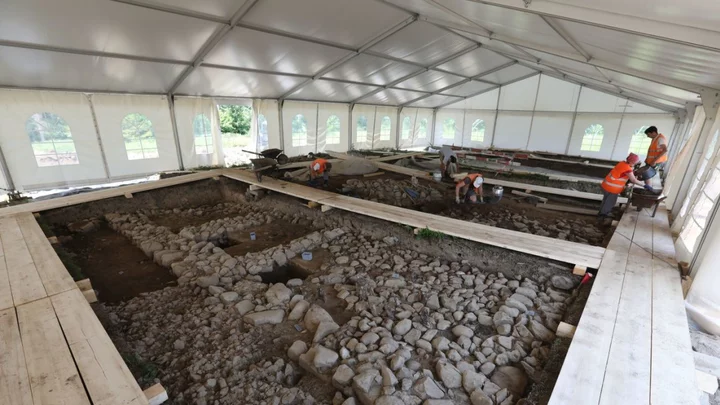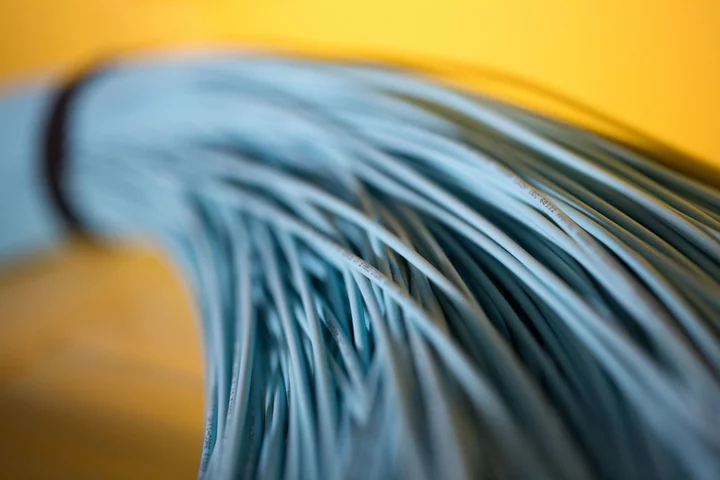
Apple’s China Troubles Catch Fund Managers Chasing Rally
For months, megacap tech shares powered US stocks to dizzying gains. The market’s engine is now starting to
1970-01-01 08:00

Discovery in Swiss Alps called an 'archaeological sensation'
The remains of 2,000-year-old Roman walls have been discovered by archaeologist in Switzerland in the foothills of the Alps. During the excavation of a gravel pit in Cham in the canton, or state, of Aug in central Switzerland, the walls, which once protected a Roman building complex, were found. Other pieces have also been unearthed by archaeologists, include a plaster wall, iron nails, and gold fragments. As well as items such as bowls, millstones for grinding, glassware, and crockery and ceramic jugs known as amphorae. In a statement form the Office for the Preservation of Monuments and Archeology, the findings were labelled an "archaeological sensation" for the region and could shed light on Roman activity in central Switzerland. Gishan Schaeren, head of the Department of Prehistory and Protohistoric Archaeology said in the statement: "Roman buildings of similar dimensions were last excavated in Cham-Heiligkreuz almost 100 years ago. We were also amazed that the top bricks were even visible above ground." The walls extend over an area of at least 5,300 square feet (500 square metres). Although it's unclear how Romans used the site, including whether it was a "villa with a view or a temple building," said professor of archaeology of the Roman provinces at the University of Bern Christa Ebnöther. The team said that findings of Roman tableware known as terra sigillata - which means "sealed earth" in Latin - were found, suggesting elite people were at the site. The amphorae, which typically held liquids such as wine, olive oil and fish sauce, are evidence that Romans in the region traded with those in the Mediterranean. Archaeologists also found several copper and bronze coins, including a silver denarius minted by Julius Caesar from the first century B.C. The discovery of the Roman walls is not the first ancient find in the area. Previously, archaeologists had found remains of a middle Bronze Age settlement, burials from the late Bronze Age, and a number of coins form the era of the Celts. Sign up to our free Indy100 weekly newsletter Have your say in our news democracy. Click the upvote icon at the top of the page to help raise this article through the indy100 rankings.
1970-01-01 08:00

European Stocks Rebound as Consumer, Retail Sectors Lead Gains
European shares climbed on Friday, trimming a weekly decline and interrupting the longest losing streak since February 2018
1970-01-01 08:00

Robotic dog brought into survey historic Cold War weapons testing facilities
A robotic dog called Spot was brought into survey two former Cold War weapons testing facilities, which are unsafe for humans to enter due to decaying concrete. The National Trust said bringing the tech to Orford Ness in Suffolk to conduct a first measured survey of the historic structures was “a key part of our commitment to ongoing research at our places”. The remote shingle spit was used as a military test site during both world wars and into the nuclear age, before the Ministry of Defence sold it to the conservation charity in 1993. The robotic dog, with a camera mounted to the top and four hinged legs, is controlled remotely and from a safe distance to explore spaces where it is unsafe for humans to go. It was used, alongside drones, to survey two laboratories known as pagodas or Labs 4 and 5 at Orford Ness. Both are classified as scheduled monuments. They were constructed in 1960 to carry out environmental tests on the atomic bomb, mimicking the rigours to which a weapon might be subjected before detonation, including vibration, extremes of temperature, shocks and G forces. Although no nuclear material was involved, a test failure could still have resulted in a catastrophic explosion. For this reason, the labs were specially designed and constructed with a shingle top which would absorb and dissipate if an explosion occurred. Glen Pearce, operations manager at the National Trust’s Orford Ness, said: “This is a really exciting opportunity for us to see inside labs four and five, the ‘pagodas’. “The buildings have always had a certain mystery about them. “When they were built and in use during the Cold War, they were shrouded in secrecy, and after they were decommissioned, they fell into disrepair. “Nobody has been able to go inside for several years due to safety reasons. “This is the first time the National Trust has employed this kind of technology and it’s a key part of our commitment to ongoing research at our places. “It could change the way we, and our visitors, engage with the structures at Orford Ness as well as other scheduled monuments and buildings deemed unsafe to enter.” No measured surveys have been completed of the buildings before, the conservation charity said. National Trust archaeologist Angus Wainwright said: “Historic England’s research into the buildings made us realise how significant they are, on a national and international scale. “These are some of the few Cold War buildings that are on this monumental scale and visitable by the public. “The buildings used to be quite safe so we could go in and out as much as we liked, but now they are getting more risky as the concrete decays. “That’s why we are doing this survey in this remote way, without anyone going into the buildings. “It’s all very experimental, to see if it’s possible to do a really detailed building survey with no human operator in the building.” The structures are part of the National Trust’s curated decay policy and have been left to nature, with their roofs becoming nesting sites for lesser black-backed gulls, which are on the UK’s amber conservation list. Colin Evison, innovation technical lead at BAM, said it was a “fantastic opportunity to put into action our agile mobile robot Spot”. He said the survey would provide a “comprehensive and valuable record of this historic environment for future generations”. Read More Charity boss speaks out over ‘traumatic’ encounter with royal aide Ukraine war’s heaviest fight rages in east - follow live Period and fertility tracking apps scrutinised over data security concerns Russian cyber-attacks ‘relentless’ as threat of WW3 grows, expert warns Warner Music sign first digital character Noonoouri and release debut single
1970-01-01 08:00

Digital payments company Square experiences outage
Square, the digital payments company, experienced outages on several services Thursday.
1970-01-01 08:00

South Korea's Hynix is looking into how its chips got into Huawei's controversial smartphone
SK Hynix, a South Korean chipmaker, is investigating how two of its memory chips mysteriously ended up inside the Mate 60 Pro, a controversial smartphone launched by Huawei last week.
1970-01-01 08:00

China’s Chip-Gear Makers Soar as US Probe Spurs Development Bets
China’s semiconductor equipment makers surged as Washington’s investigation into chips used for Huawei Technologies Co.’s new smartphone spurred
1970-01-01 08:00

Faraday Future alleges "coordinated effort" to undermine valuation
Faraday Future Intelligent Electric on Thursday said it has recently observed a series of "suspicious activities" which the
1970-01-01 08:00

Huawei Debuts Even More Powerful Phone as Controversy Swirls
Huawei Technologies Co. added a new top-of-the-line model to its controversial Mate 60 smartphone family on Friday, putting
1970-01-01 08:00

Nomura Crypto Chief Warns Market Rout May Delay Unit’s Profit
Nomura Holdings Inc.’s crypto unit may take longer than expected to break even after a rout in digital
1970-01-01 08:00

Indosat Considers Stake Sale in $1 Billion Fiber Assets
Indosat Ooredoo Hutchison is considering options for its fiber assets including a stake sale, according to people familiar
1970-01-01 08:00

Australia to require AI-made child abuse material be removed from search results
SYDNEY Australia will make search engines like Google and Bing take steps to prevent the sharing of child
1970-01-01 08:00
